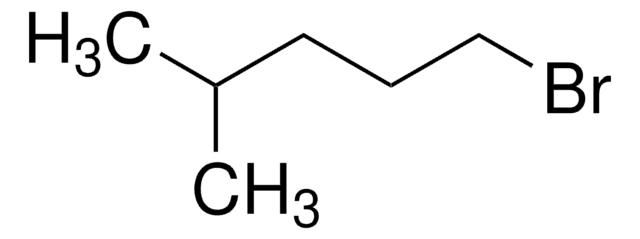493953
5-Methyl-1-hexanol
97%
Sinónimos:
5-Methylhexanol
Seleccione un Tamaño
63,50 €
Precio de catálogo127,00 €Ahorre 50 %Seleccione un Tamaño
About This Item
63,50 €
Precio de catálogo127,00 €Ahorre 50 %Productos recomendados
Nivel de calidad
Ensayo
97%
índice de refracción
n20/D 1.422 (lit.)
bp
167-168 °C (lit.)
densidad
0.823 g/mL at 25 °C (lit.)
grupo funcional
hydroxyl
cadena SMILES
CC(C)CCCCO
InChI
1S/C7H16O/c1-7(2)5-3-4-6-8/h7-8H,3-6H2,1-2H3
Clave InChI
ZVHAANQOQZVVFD-UHFFFAOYSA-N
Categorías relacionadas
Palabra de señalización
Warning
Frases de peligro
Consejos de prudencia
Clasificaciones de peligro
Acute Tox. 4 Oral - Flam. Liq. 3 - Skin Irrit. 2
Código de clase de almacenamiento
3 - Flammable liquids
Clase de riesgo para el agua (WGK)
WGK 3
Punto de inflamabilidad (°F)
86.0 °F
Punto de inflamabilidad (°C)
30 °C
Elija entre una de las versiones más recientes:
¿Ya tiene este producto?
Encuentre la documentación para los productos que ha comprado recientemente en la Biblioteca de documentos.
Los clientes también vieron
Filtros activos
Nuestro equipo de científicos tiene experiencia en todas las áreas de investigación: Ciencias de la vida, Ciencia de los materiales, Síntesis química, Cromatografía, Analítica y muchas otras.
Póngase en contacto con el Servicio técnico












